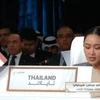Bangkok (VNA) - Thailand has set a target of rice exports of 7-7.5 million tonnes next year, up from an estimated 6 million tonnes this year, helped by sufficient water supply and a weak baht, making Thai grains more competitive.
Speaking after a discussion with senior Commerce Ministry officials, Charoen Laothammatas, president of the Thai Rice Exporters Association, said in 2021, Thailand is projected to remain the world’s third-largest rice exporters, followed by India and Vietnam, Bangkok Post reported.
It is expected to finish the year with rice exports of 6-6.3 million tonnes, slightly higher than 5.72 tonnes last year. Thai rice production is expected to increase in the 2021/2022 harvest season, with milled rice production estimated at 20 million tonnes due to plentiful water supplies, up from 17 million tonnes in the 2020-2021 season.
Abundant water supplies and a weaker baht are expected to boost Thailand's rice exports next year, according to Charoen. The baht’s weakness has made Thai rice export prices more competitive, with the free-on-board prices of 5 percent white rice now offered at 390 USD per tonne, lower than 405 USD per ton of Vietnam.
However, he said container shortages and a lack of shipping space are expected to remain key risk factors, likely to persist until the first half of 2022.
To upgrade Thailand's ranking in the world rice export market, it is a must for the country to speed up developing Thai rice varieties, Charoen said adding that Thailand also has to develop new varieties of fragrant rice and promote them vigorously to compete with other producers.
Thailand has limited the supply of rice varieties to serve customer demand, especially soft-textured white rice.
Chookiat Ophaswongse, honourary president of the Thai Rice Exporters Association, recently said rice export volume is likely to gradually drop if Thailand fails to improve Thai rice varieties to meet customer demand, such as offering soft-textured rice and ignores improving productivity.
Thailand's average rice productivity is 450 kilogrammes per rai which equals to 0.16ha, significantly lower than Vietnam's at 900kg per rai and India's at 800kg.
He said Thailand hasn’t tackled the problems at their root, focusing instead largely on price support, either via rice pledging or price guarantee schemes. Vietnam focuses on R&D to strengthen its rice industry./.























